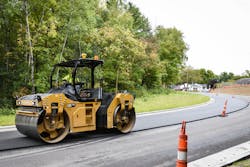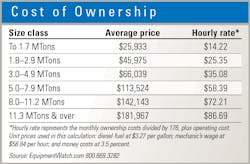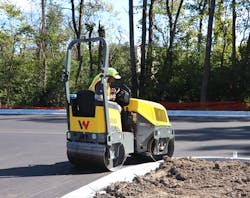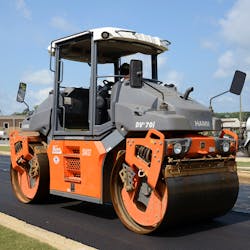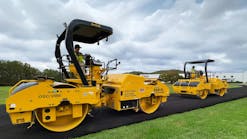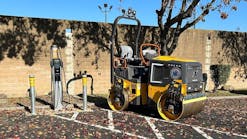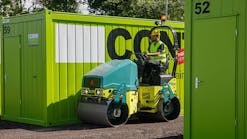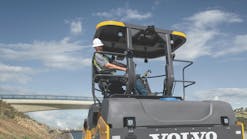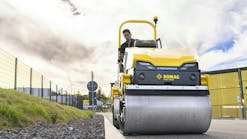How Rollers Benefit from Technology
“Tandems account for nearly half of all compactors produced and sold each year,” says industry market expert Chuck Yengst, president of Yengst & Associates. “Annual sales of tandem vibratory compactors are about 3,500 per year for the industry over the past three years. About 60 percent of tandem sales are machines rated under 5 metric tons. Machines from 5 to 8 metric tons are about 10 percent of the total, and machines over 8 metric tons are roughly 30 percent.”
Yengst says the key players are Caterpillar, Hamm (now part of John Deere), Volvo Construction Equipment, Dynapac, and BOMAG. “A number of smaller players, including Wacker Neuson and Hyundai, account for a limited amount of market share,” he says.
“The market is growing slowly and likely to improve by 7 to 8 percent in 2019 versus 2018,” Yengst says. “Longer term, demand for tandems will likely continue to improve, but the real question is whether or not we will ever see Congress pass an infrastructure bill. If a bill passes someday, demand will improve considerably for these machines. Without a bill, sales will be cyclical, with growth at about 3 percent annually on average for five years.”
Vince Hunt, product manager, compaction and concrete, for Wacker Neuson, says he’s seen an even more robust market for rollers. “The market for tandem rollers in North America remains very strong,” he says. “Overall, total industry market growth has been around 10 to 12 percent per year for the past few years.
“Last year was a banner year for Wacker Neuson, and this year should be on par with 2018,” Hunt adds. “Reasons for the good market are due to overall construction spending for both residential and nonresidential projects, as well as continued spending at the local, state, and federal levels.”
Bryan Downing, Caterpillar’s global sales consultant, stresses several factors for managers considering a roller purchase. “When selecting a tandem vibratory roller, machine versatility, simplicity of machine operation, and machine uptime are the most important factors,” Downing says.
“Machine versatility is further defined as multiple amplitudes to create different compaction energies to create compaction in the fewest number of passes,” Downing says. “Simplicity of machine operation makes machine and speed set-up simple for operators to create the most uniform compaction. Lastly, machine uptime is targeting the lowest operation costs with very high reliability.”
Tips for acquiring double drum rollers
Case Construction Equipment’s Nathaniel Waldschmidt, product manager for compaction, points out more considerations.
“First, look for a machine with crab offset,” Waldschmidt says. “The ability to offset drums is important for a couple of reasons. When compacting asphalt on a roadway or another large-scale project, it’s important to bind each pass together. By having a compaction machine that allows you to have the rollers either in-line or offset, you’re able to have an overlap of up to 6 inches to bind the two passes together. It also offers tighter turning radiuses for added maneuverability when compacting in confined areas.
“A roller with high curb clearance also helps in terms of maneuverability and is excellent for work in residential or commercial areas by allowing the operator to work right up to existing curbs and other low structures,” Waldschmidt says.
Dynapac senior product manager Vijay Palanisamy keys in on what he calls value-added features. “Rollers that provide the best performance combined with additional long-term value-adds get the best bang for your buck,” he says.
“First, find rollers with lower fuel consumption,” Palanisamy says. “A 20-percent fuel consumption reduction is almost $35,000 to $40,000 savings over the life of the roller. Also, consider added features that enhance the productivity, quality, and safety, such as temperature sensors, drum edge lights, drum offset, and telematics. Finally, think about extended warranties and service contracts from manufacturers and suppliers that can eliminate future risks and unseen costs.”
Along the same lines, Hunt stresses the importance of product support. “The most important considerations for managers to think about are product reliability and support from their dealers,” Hunt says. “Overall aftermarket support in the field is also crucial. I often hear contactors say that they prefer to work with ‘XYZ’ dealer because they are responsive to their needs. Essentially, it comes down to trust and responsiveness.”
Mark Eckert, compaction product manager for Volvo Construction Equipment, says managers should focus on features that can help their operators produce better mats.
“Seemingly small mistakes by the operator can have an enormous impact on mat quality,” Eckert says. “That’s why many of the new features Volvo has developed over the past few years are designed to assist operators and help automate compactor functions. Speed limiters, auto vibration, automatic water spray, and impact spacing meters are perfect examples of technologies that help automate tasks that could cause mat quality problems, and really help to make compactor functions easier for the operator.
“Our advanced drum vibration system diminishes start-up power consumption for optimum performance,” Eckert says. “Adaptive power, auto-idle, and auto-engine shutdown allow operators to improve fuel efficiency without compromising performance.”
OEMs continue to greet the vibrant market with added features and technology. Following is a small sampling of some key features and systems available.
Cat’s latest advancement on tandem rollers involves vibratory system offerings and operator interfaces. “In vibratory offerings, we now offer an oscillatory rear drum combined with our conventional vibratory systems on the front drum,” Downing says. “This brings the value of the oscillatory compaction energy into areas sensitive to conventional vibration.”
Caterpillar has also created a dual drum “smart system” called the Automatic Adjustable Compaction (AAC) system. According to Downing, the AAC system changes compaction energy to optimize each pass to deliver the maximum compaction energy in initial passes to drive the quickest compaction growth, then reduces the compaction energy to preserve the compaction quality.
“This important compaction energy optimization is coupled with one simple set-up for operators; simply select the automatic mode, activate the compaction system, and drive a uniform pattern,” Downing says. “Finally, we continue to refine operator’s controls so that operation remains intuitive and simple for operators so that they can focus on driving uniform patterns with proper techniques.”
Volvo has an optional Intelligent Compaction system, called Compact Assist with Density Direct. Density Direct allows the operator to see real-time estimated density values across 100 percent of the mat. Compact Assist also features pass mapping and temperature mapping functionality, as well as data collection capabilities for integration with Veta data management and analysis software.
One of Hamm’s most important systems for managers is its Hammtronics engine-management system, says Hamm compaction product manager Tim Kowalski. It is currently offered as standard equipment on the company’s HD+, DV+, and H Series rollers. “It’s an engine-management system that provides power on demand; you don’t have to run the machine at wide open rpm when you’re not doing anything,” he says. “It’s probably saved anywhere from 10 to 20 percent in some cases, as far as fuel usage.”
The system works by having an established rpm that ramps up in anticipation of the task selected by the operator. “If you’re sitting at idle in park, the machine is at a certain rpm,” Kowalski says. “As soon as you take it out of park, it goes to another rpm knowing that it’s going to start moving. When it starts moving, it goes to yet another rpm, and when you want to start vibration, it increases the rpm again so it doesn’t bog the motor down getting there. When you need the power is when it gives you the power.”
Case’s Waldschmidt provides a good summary on some of the technology, including compaction meters, high-frequency rollers, and variable amplitude settings, and the key difference between stiffness and density.
“Compaction meters measure the amount of rebound at each drum as they go over an area,” Waldschmidt says. “If the machine passes over an area and does not register any rebound during soil compaction, for instance, that lets the operator know they’ve hit a bad area that requires attention. On the contrary, if the meter is registering full rebound, the operator will know to avoid over-compaction of that area. The compaction meter helps identify areas that will require added attention prior to testing.”
Another relatively recent advance, Waldschmidt says, is the introduction of high-frequency rollers. “With some machines offering frequencies up to 67 hertz or above, these higher frequency ranges offer operators more control over compaction performance based on the thickness and density requirements of the lift,” he says.
Using higher frequency with variable amplitude settings allows rollers to be “dialed in” to handle thinner lifts (low amplitude/high frequency) and thicker lifts (high amplitude/low frequency), according to Waldschmidt. “Centrifugal force can also be adjusted to best match the thickness of the lift and the desired depth of compaction. The ability to dial-in and finely tune these settings allows for greater onsite productivity, and further reduces the possibility of rework,” he says.
“Some modern compaction equipment provides the operator with recommended operating settings/conditions based on the feedback it gets from real-time conditions of the compacted material,” Waldschmidt says. “This is based on desired stiffness settings. The desired stiffness is preset based on a benchmark pass that’s already met requirements. It lets the operator know within a range of where they should be operating as the compactor travels along. The display screen shows operators the miles per hour they should be traveling as well as the level of vibration that should be set. The operator still handles all the adjustments, but the system provides them with operational guidelines.”
Waldschmidt says it’s important to note that these technologies measure stiffness, not density. “Nuclear density meters, the most accepted measurement tools in the industry, measure how dense the ground is. Measuring stiffness is said to be a better indicator than density,” he says. “If a company strictly goes off of the data from a nuclear density meter, they’re not getting load-bearing capabilities. A nuclear density test is still required, but it will be more accurate and there will be a higher chance of passing if intelligent compaction features are used.”
